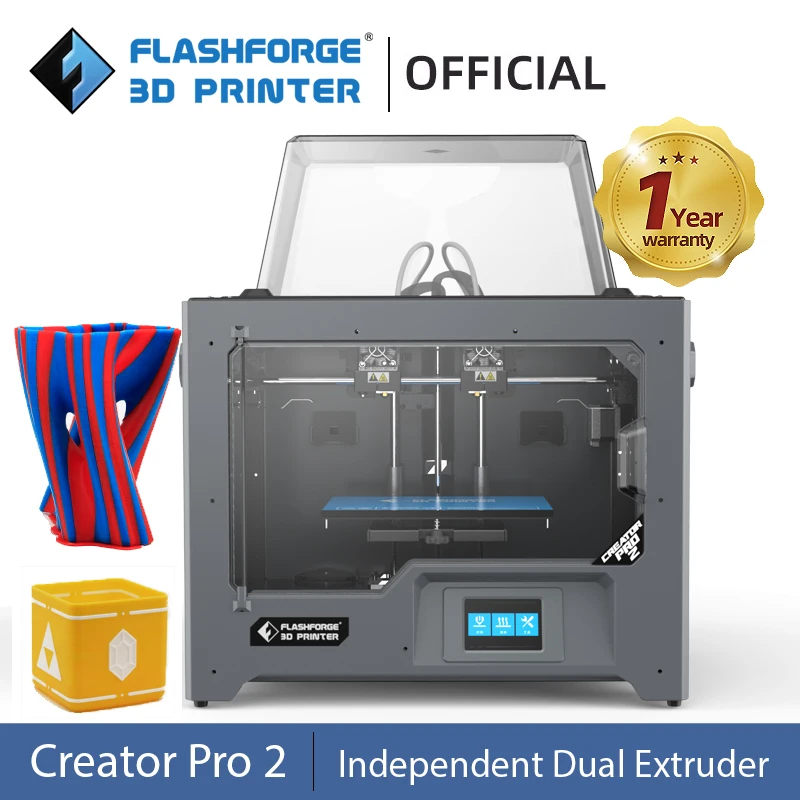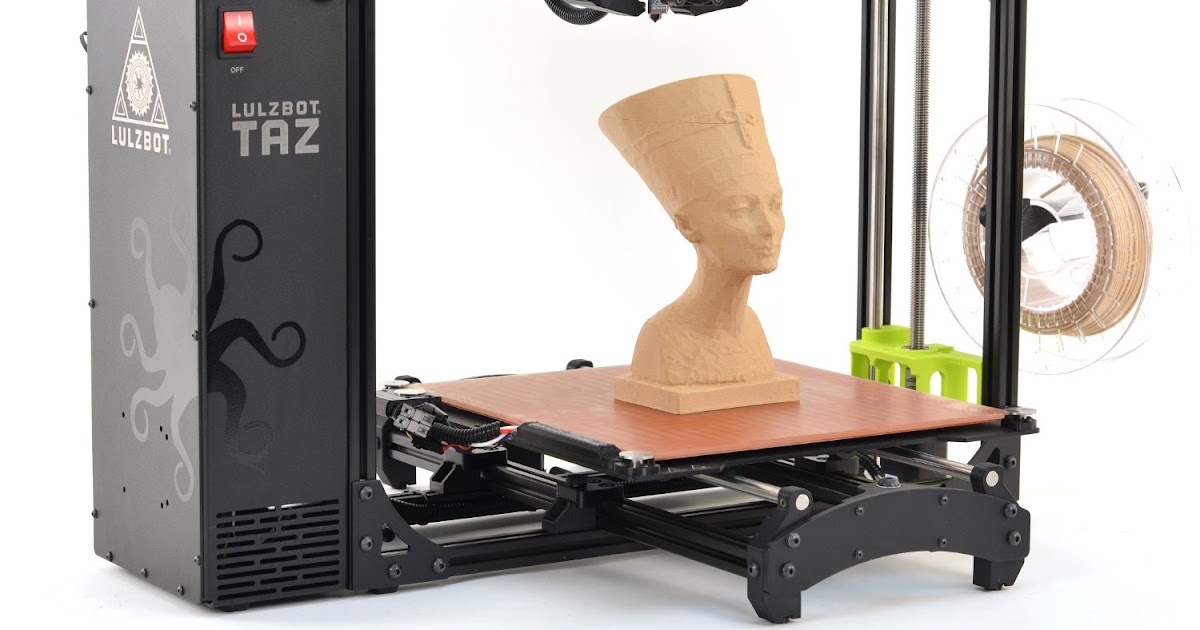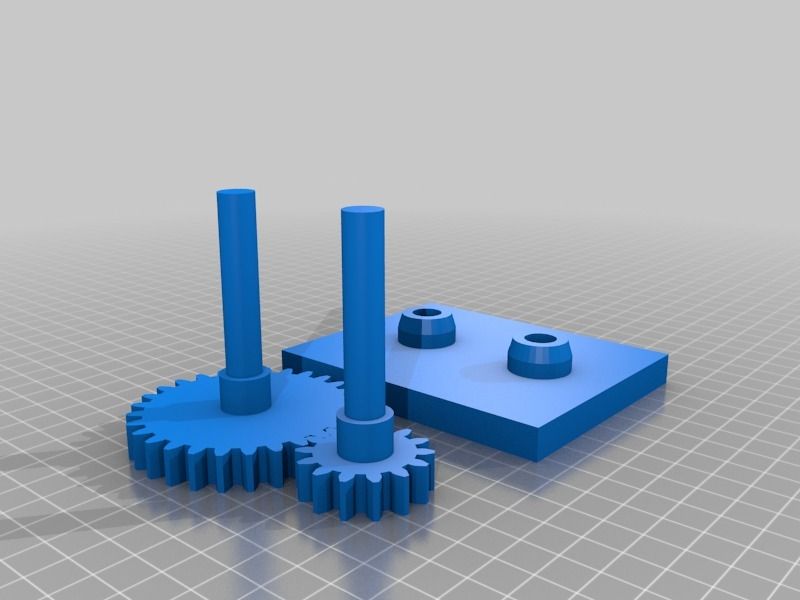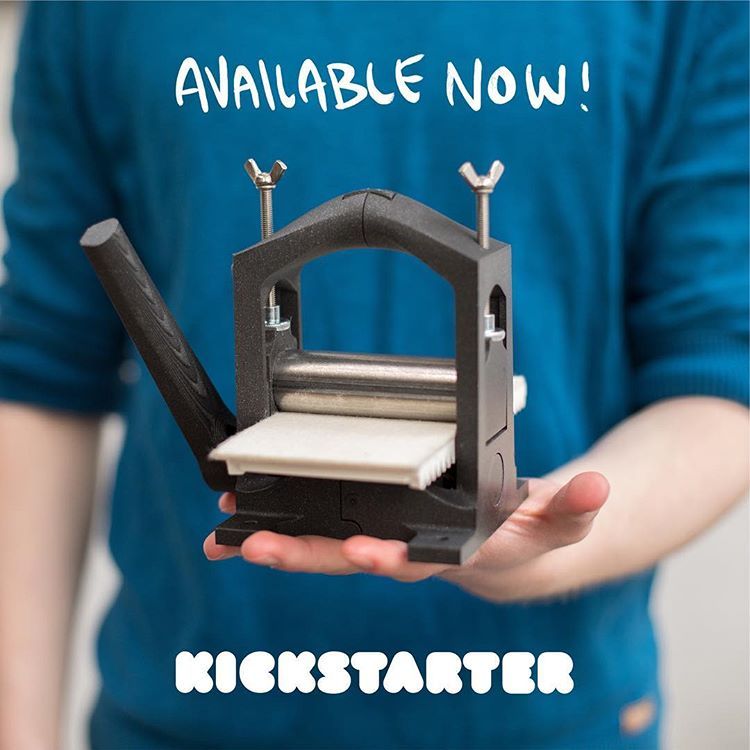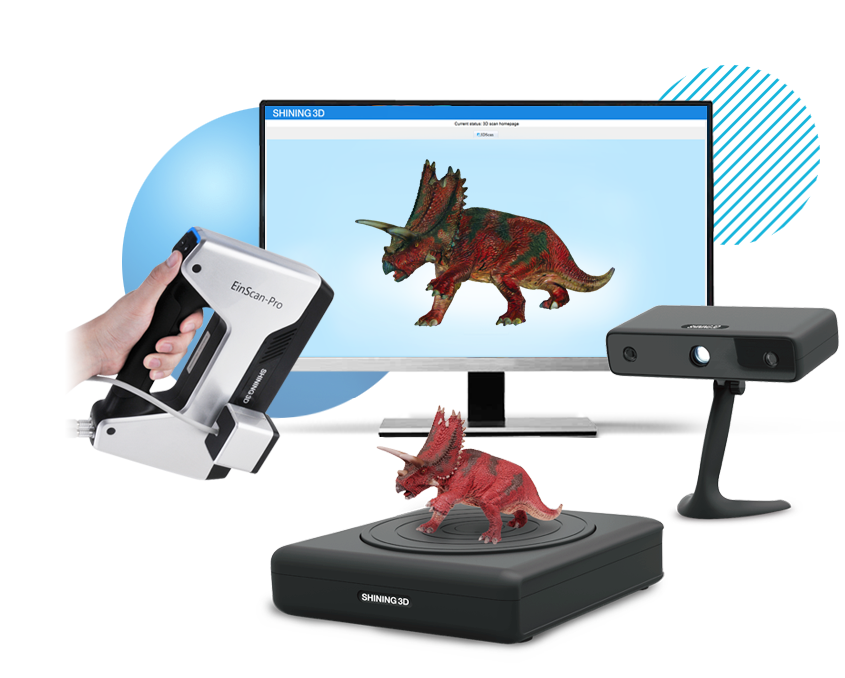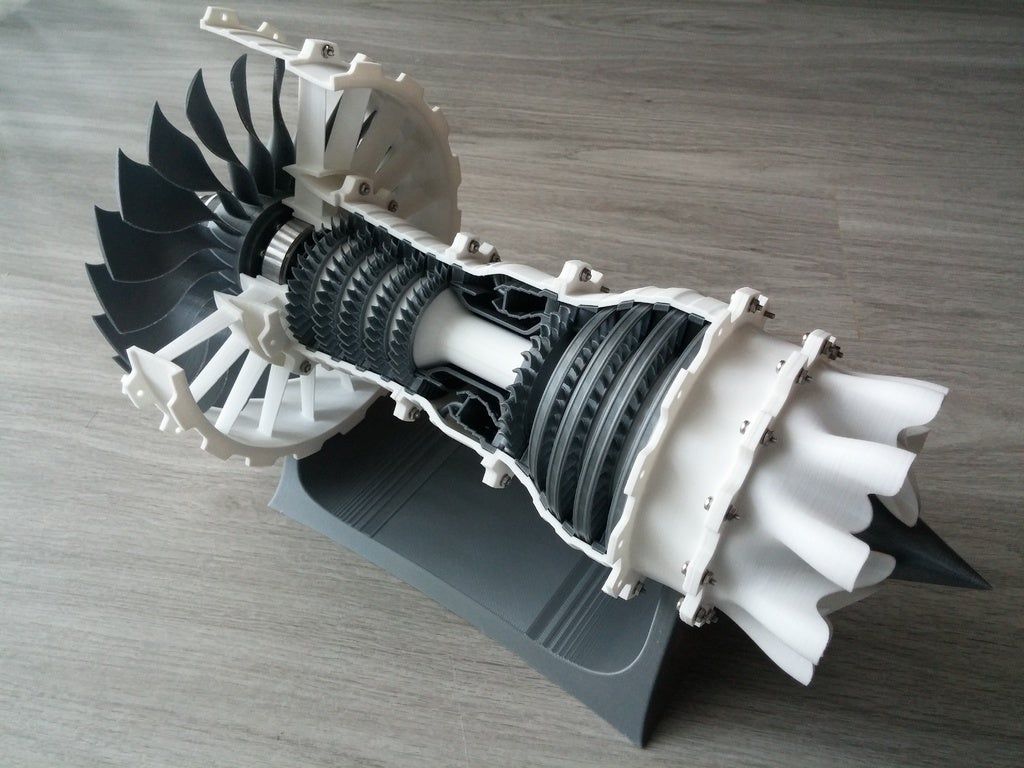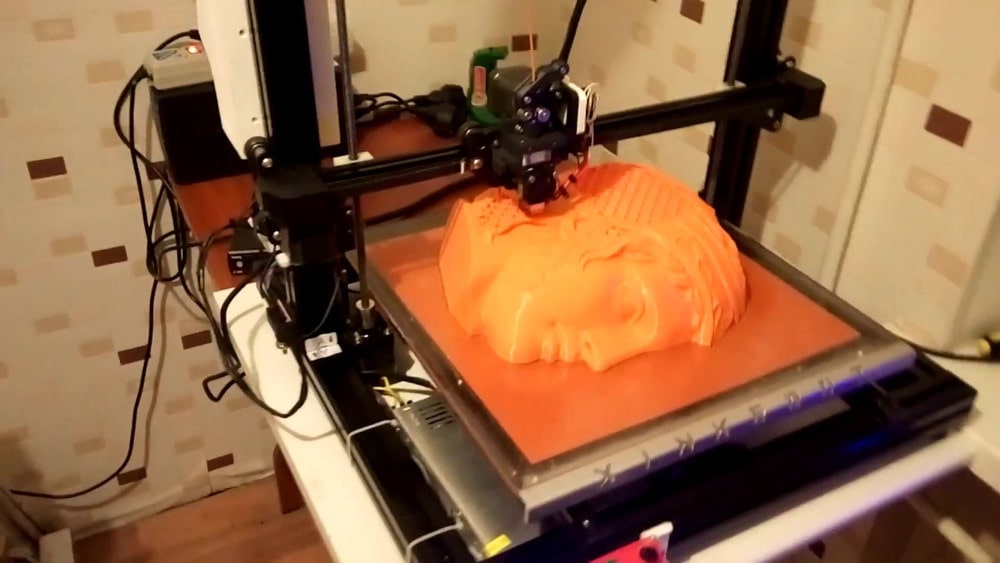Flashforge creator max dual extruder 3d printer
FlashForge Creator Max 2 Independent Dual Extruder 3D Printer, Open-Source, Wi-Fi Enabled, 50 Microns, Touchscreen – FlashForge USA
Skip to contentAdvanced, Reliable, and Easy-To-Use
FlashForge Creator Max 2 equips with an industry leading independent dual extruder system for maximizing productivity and efficiency while a fully enclosed printing chamber provides an added printing performance.
As with all FlashForge 3D printer models, operations of Creator Max 2 are easy with a high definition IPS full-color touchscreen.
Filament Extruder Scraper
Scrape off filament residuals automatically when extruding for a perfect print.
Independent Dual Extruder
Support mirror printing mode, duplicate printing mode and soluble printing mode
Touchscreen Interface
HD IPS Full-Color Touch Screen
Metal Frame
Provides stability during printing and printing accuracy
Build Volume
200 x 148 x 150 MM (7. 9 x 5.8 x 5.9 IN)
Filament Compatibility
PLA, High Speed PLA, PLA Color Change, ABS, ABS Pro, HIPS, Elastic(TPU 95A), and PVA
Heated Build Plate
Maximum Heated Build Temperature 120°C (248°F)
Optional Flexible and Removable Build Platform
This optional flexible and removable build platform saves you time when removing prints on your Creator Max 2. You will be off to a new print job in a matter of seconds.
SPECIFICATIONS
Printing
Dual Independent Extruder
Print Technology: FFF
Maximum Printing Temperature: 240℃ (464°F)
Build Volume: 200 x 148 x 150 MM (7.9 x 5.8 x 5.9 IN)
Mirror Mode Volume: 80 x 48 x 150 MM (3.1 x 1.9 x 5.9 IN)
Duplicate Mode Volume: 95 x 148 x 150 MM (3.7 x 5.8 x 5.9 IN)
Nozzle Diameter: 0. 4 MM (0.015 IN)
4 MM (0.015 IN)
Filament Diameter: 1.75 MM (0.069 IN)
Filament Compatibility: PLA, Ultra Strong PLA, PETG, PVA, ABS, ABS Pro, HIPS
Print Speed: 10-100mm/s
Maximum Build Plate Temperature: 120℃ (248°F)
Device
Printer Dimensions: 526 x 360 x 403 MM (20.7 x 14.2 x 15.9 IN)
Shipping Box: 560 x 415 x 500 MM (20.1 x 16.4 x 19.7 IN)
Screen: High Definition Touch Screen Control Interface
Net Weight: 15 KG (33 LBS)
Gross Weight: 21 KG (46.3 LBS)
Spool: External with 2 Spool Holders
Software & Connectivity
Software: FlashPrint
Input: 3MF, STL, OBJ, FPP, BMP, PNG, JPG, JPEG files
Output: GX/G files
Power: 100-240 VAC,47-63Hz
Connectivity: USB Cable, SD Card
Supports (OS): Windows and Mac OS
What's in the Box
Creator Max 2 3D Printer
Filament
Top Cover
Leveling Card
Quick Start Guide
Power Cable
USB Cable
SD Card
Spool Holder
Build Tape (6 Pcs)
Flexible Build Plate Kit
0.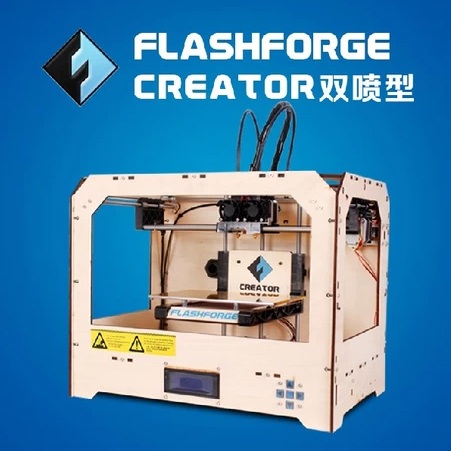 4 MM Nozzle (4 Pcs)
4 MM Nozzle (4 Pcs)
Screw Driver
Stamping Wrench
Allen Wrench
PTFE Tube (12 Pcs)
Filament Guide Tube
Grease
Unclogging Pin Tool
Scraper
Leveling Nut
XY Calibration Tool
Glue Stick
Anti-Oozing Plate
We Recommended
FlashForge Creator MAX Dual Extrusion 3D Printer
- Home
- Store
- Sale
- Sale
Just like its predecessor, the Creator PRO, the Creator MAX has the same durability and performance, but with a few great upgrades for better, faster, and more accurate prints.
Some of the upgrades include an LED screen with touch screen interface, temperature control for various filaments, WiFi connectivity for cloud printing, and so much more.
Disclaimer* Shipping is only covered within the lower 48 states, the following US territories are not covered; Alaska, Hawaii, Puerto Rico, U. S. Virgin Islands, & American Samoa.
S. Virgin Islands, & American Samoa.
Remove from wishlist Add to wishlist loading...
Available Add-ons (3)
Show More Addons
Product No. M-W7Z-2YD3
| List Price: | $879.00 |
|---|---|
| Price: | $679.00 |
| Price: | $... |
| Order Now: | Ships in 1-3 business days Free U.S. Shipping |
The Creator MAX comes equipped with a build plate with 6.3mm aerospace-grade aluminum. This allows the temperature to remain consistent during your print, especially while printing with ABS. It also prevents external elements from interfering with your print.
The Z-axis rod on the Creator MAX is supported by a 10mm guide rod which makes your prints more steady and precise.
With a fully enclosed dual extrusion 3D printer, Creator Max brings versatility and reliability for your 3D printing experience.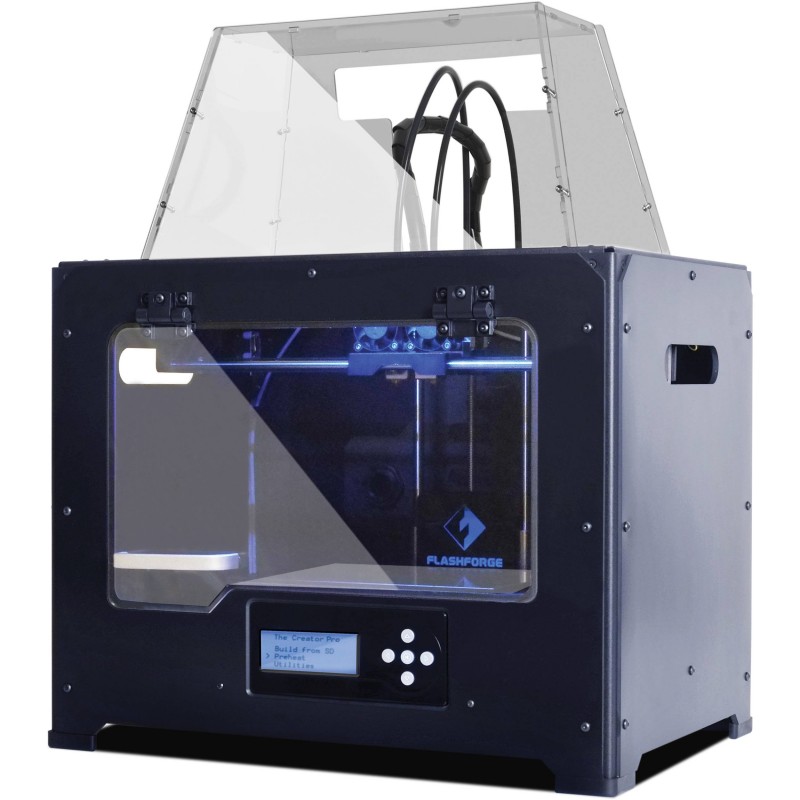
- Fully Enclosed metal frame design with acrylic cover and door
- Temperature control for various filaments
- Warp-resistant 6.3mm aluminum build platform remains perfectly level under the stress of high heat
- Dual extrusion
- Heat-resistant metal platform supports replace plastic supports.
- Heavy-duty (10mm) z-axis guide rod ensures a steady and precise movement.
- Acrylic cover encloses the chamber to insulate and protect ABS prints.
- LED light illuminates the build chamber.
- Integrated LCD screen and button board functions error-free
- LED touch screen display
- 6.5mm alloy build platform
- Build envelope: 225 x 145 x 150 mm.
- Build volume: About 5 liters
- Layer thickness: 0.1-0.3 mm. (adjustable)
- Nozzle diameter: 0.4 mm.
- Works well with 1.75 mm ABS and PLA
- Overall dimensions: 320 x 467 x 381 mm.

- Packing dimension: 590 x 470 x 580 mm.
- FlashForge Creator MAX
- Lid
- Power Cable
- SD card
- 2 filament guide tubes
- 2 build tape
- Users Manual
- Leveling Card
- Toolbag containing nuts, screws, and hex wrench set.
- Extruders accessory kit
- One Spool of Flashforge PLA filament
Best 3D Printers of 2022 | Rating of TOP models of 3D printers for printing
Contents [Show]
The modern market of additive equipment offers many options for 3D printing equipment designed to solve various problems. Devices are in demand in engineering and design, architecture, medicine, industry, education, entertainment, engineering and many other fields.
Let's talk about what you should pay attention to when choosing a 3D printer, and also consider the rating of the best equipment models for amateurs and professionals in 2022.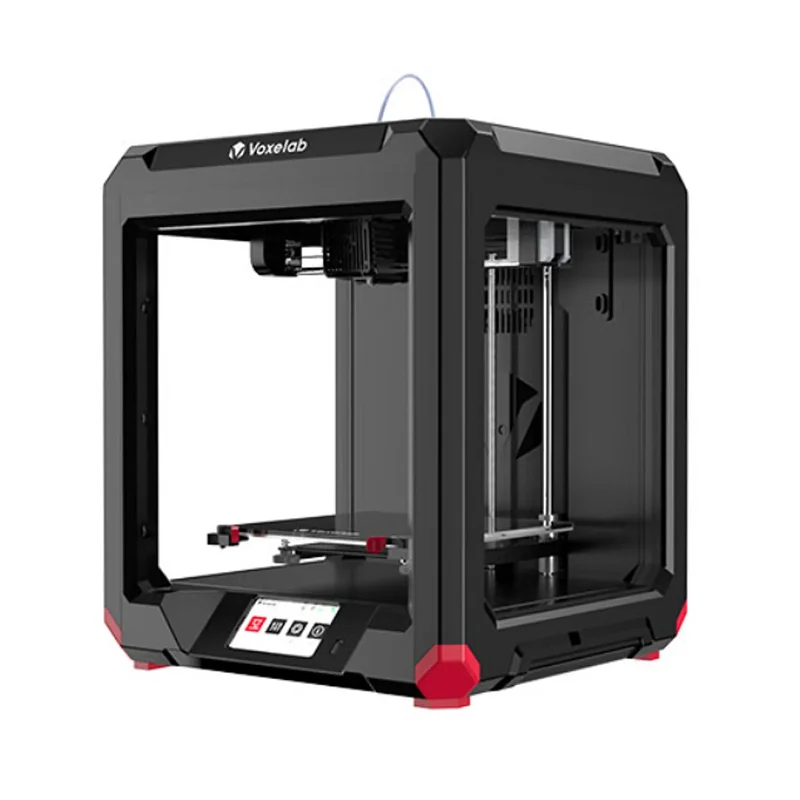
How to choose the right 3D printer
There are a number of basic parameters that you need to pay attention to when choosing a printer for bulk printing. Let's briefly consider each of them.
Printer type
According to the ISO / ASTM 52900: 2021 standard, approved by the International Organization for Standardization, 3D printers are divided into several categories depending on the characteristics of the printing process (for convenience, we will duplicate the trade names for each category):
- DED (SLS, MJF) - deposition and melting of material using a directed electron or laser beam.
- BJT (CJP, NPJT) - selective jet application of a binder composition to the powder for its sintering.
- MJT (MJP) - layer-by-layer inkjet application of photopolymer resin.
- MEX (FDM, FFF, PJP) - layer-by-layer application of the consumable through a heated nozzle (extrusion).
- VPP (SLA, DLP, LCD, CDLP) - photopolymerization, selective curing of a liquid photopolymer in a bath under the influence of a light source.
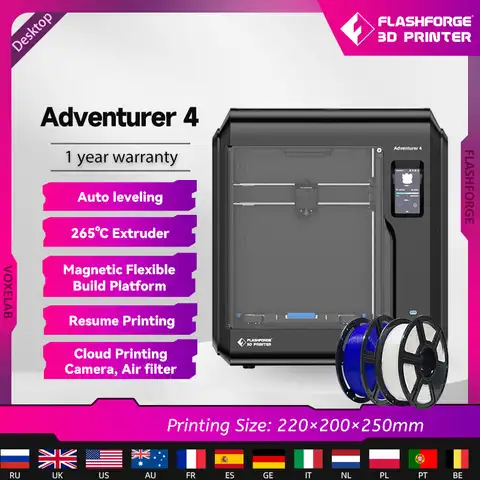
- SHL (LOM, Composite Lamination) - gluing (lamination) of sheets of material.
- PBF (SLM, DMLS, EBM) - fusion of certain areas of the powder layer under the influence of thermal energy.
Approval
This parameter largely depends on the printing technology and is standardly described in the vertical and horizontal planes (Z and XY, respectively).
The Z resolution is the height/thickness of the layer. The thinner the layer, the more accurate and detailed the model will be. XY resolution is the smallest possible movement of the print head, which cannot be less than the diameter of the nozzle or laser beam.
The highest resolution is provided by photopolymer 3D printers.
Compatible materials
The choice of consumable depends on the 3D printing technology used. FDM printers use special thermoplastics in the form of filaments (PLA, HIPS, ABS, PET, PETG, Wood, Flex, etc.), while photopolymer printers use various light-sensitive liquid resins.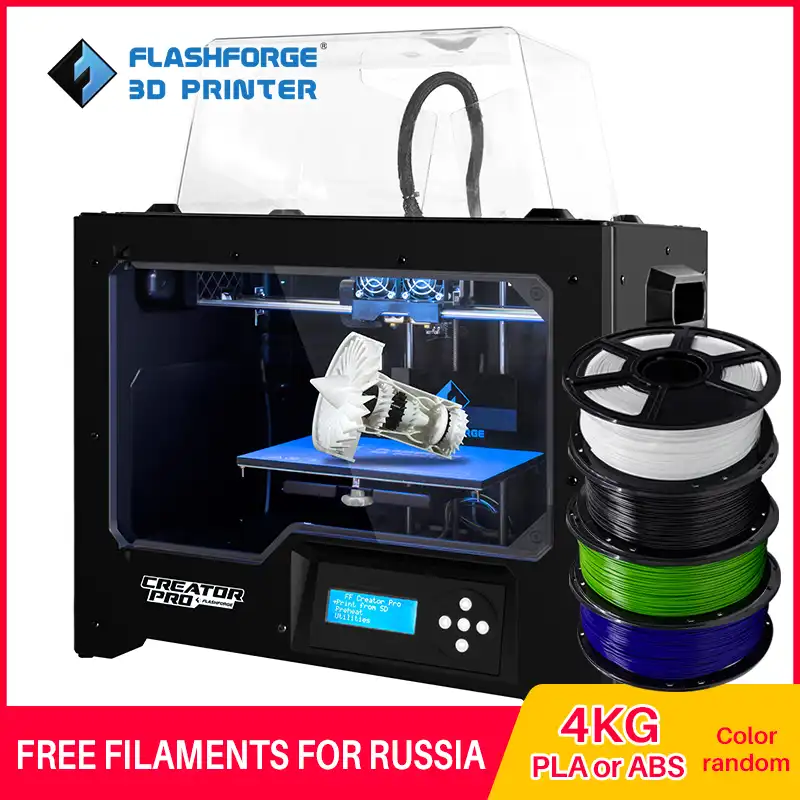 Sintering technology devices are designed to use engineering thermoplastics or metals in powder form.
Sintering technology devices are designed to use engineering thermoplastics or metals in powder form.
Many professional printers work with special purpose materials - composites (glass-filled materials, carbon fiber, etc.), metals, wood, concrete, ceramics, dental photopolymers, wax, etc.
Print platform (desktop, build platform)
This is the plate on which objects are printed. A high-quality platform ensures reliable adhesion of models to the surface (adhesion) during printing and at the same time makes it easy to separate them at the end of the process.
Typically, the print bed is made of glass, but other materials can also be used. To improve the contact of the material with the platform, special sprays and adhesives increase adhesion (Adhesion). Professional models of 3D printers usually have features that increase the resistance of printing to failures:
- flexible, removable or magnetic platform;
- automatic print area alignment system;
- heated platform for handling high temperature materials.

Security
3D printing can be associated with some risks even when all safety regulations are followed. For example, high-temperature printing increases the risk of burns, and some powder materials or photopolymer resins are harmful to the skin.
To reduce the risk of exposure to toxic substances, some printers recommend the use of protective chambers, air filtration and ventilation systems, protective gloves, and goggles. There are also models of 3D printers designed to be serviced exclusively by trained personnel.
Noise level and motor drivers
Drivers and stepper motors directly affect the noise level during equipment operation. More advanced and expensive drivers, coupled with high-quality stepper motors, contribute to a significant reduction in the noise level during the printing process.
Self assembly
Most manufacturers offer additive devices that are ready to go. But some models of 3D printers are presented as self-assembly kits (DIY kits). When buying, you need to consider that assembling such a device can cause certain difficulties, especially for the first time.
When buying, you need to consider that assembling such a device can cause certain difficulties, especially for the first time.
Product size
The choice of the area of the working area of the equipment depends on the dimensions of the parts that are planned to be printed on a 3D printer. For a home, it is enough to purchase a device with parameters up to 200x250x200 (WxHxD). This is enough to solve most problems. For more serious tasks, we recommend considering models with a working area of at least 306x306x610 (WxHxD), such a print volume will allow you to print large objects without subsequent gluing with the same print quality and resolution.
Technology
Let's take a closer look at the main technologies used in the field of 3D printing:
- FDM is a method of layer-by-layer deposition of plastic filament threads. Ideal for creating functional prototypes and parts from high-strength industrial plastics.
- DLP - layer-by-layer curing of photopolymer resins using LED projectors.
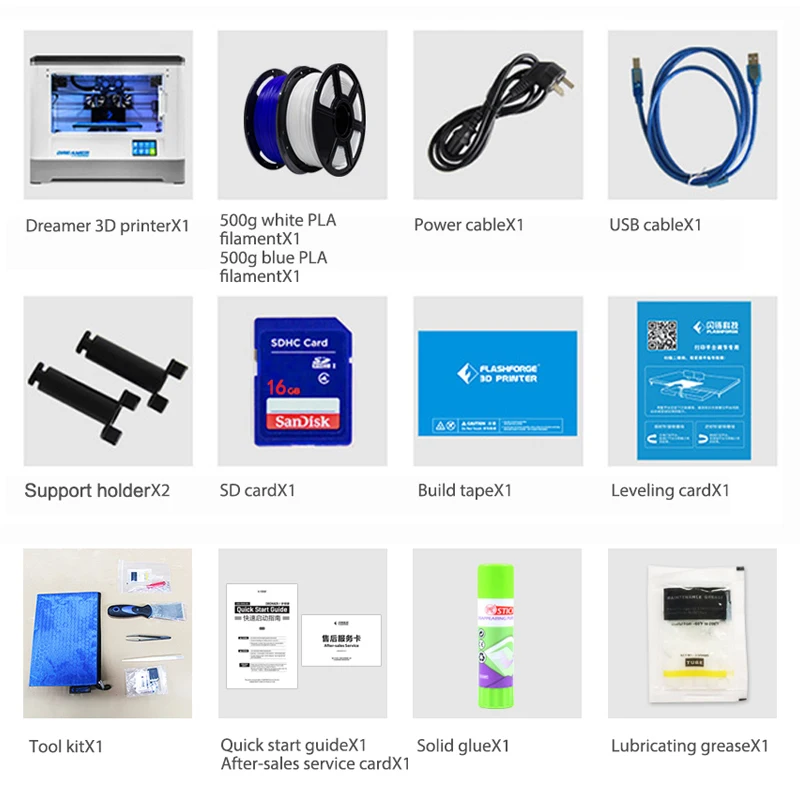 Allows you to produce ultra-precise, highly detailed objects with a high-quality surface.
Allows you to produce ultra-precise, highly detailed objects with a high-quality surface. - SLA - curing layers of liquid photopolymer using a laser beam. Suitable for printing very precise products with complex geometry and fine details.
Multicolour printing
There are modifications of printers that support the function of printing in two or more colors. Most of these FDM devices are equipped with two presses filled with threads of different colors. A separate file is used to print each color, and sections of different colors are combined with each other like a three-dimensional puzzle. There are also color powder printing technologies, such as CJP or MJM, but the range of their application is limited to simple layout or prototyping.
Print surface
The surface quality of finished models depends on both the technology used and the print resolution. If necessary, the products are easily amenable to post-processing.
Housing type
Volumetric printers are available in an open or closed case. Open type devices are cheaper, but may have print quality issues and shrinkage of ABS products due to temperature differences. Enclosed printers have a more rigid, stable design and deliver high quality builds because their print surface is protected from dust and other unwanted particles. In addition, they have a low noise level and are safer to operate.
Open type devices are cheaper, but may have print quality issues and shrinkage of ABS products due to temperature differences. Enclosed printers have a more rigid, stable design and deliver high quality builds because their print surface is protected from dust and other unwanted particles. In addition, they have a low noise level and are safer to operate.
Connection
The majority of modern 3D printers have built-in memory, a port for USB flash drives or are equipped with SD memory cards, which allows you to continue the 3D printing process without a permanent connection to a PC. Some devices may also support wireless technology (Wi-Fi or P2P) or connect via Ethernet. Recently, more and more manufacturers include in their devices the possibility of forming 3D printing farms from a cluster of devices connected by one local network.
Software
Additive technology comes with special software or is compatible with open-source programs that can be downloaded, for example, from the manufacturer's website. As a rule, the software runs on Windows, Linux or MacOS. The software package may include modules for optimizing 3D models, building automatic supports (supports), controlling the movement of the printing block and desktop, and advanced preparation of layers for printing.
As a rule, the software runs on Windows, Linux or MacOS. The software package may include modules for optimizing 3D models, building automatic supports (supports), controlling the movement of the printing block and desktop, and advanced preparation of layers for printing.
3D printer models
Consider the different models of amateur and professional 3D printers recognized as the best in 2022.
Assembly kits
Self-assembly kits (DIY) are the most budgetary and popular variant of FDM/FFF/PJP 3D printers in Russia. The use of such kits allows you to independently assemble, configure, reconfigure and upgrade printing devices to suit your needs.
The most popular DIY kits in 2022:
Creality Ender 3
Thoughtfully designed home 3D printer with open chamber, large build area (WxHxD: 220x250x220mm) and high print quality at speeds up to 180mm/s. Works great with PLA, ABS, PETG, TPU, Wood and other plastics. Equipped with a single extruder, a heated worktable, a compact display that shows the main parameters, and an active cooling system. Suitable for printing small functional items, prototypes or decorative figurines. Connects via USB or microSD.
Suitable for printing small functional items, prototypes or decorative figurines. Connects via USB or microSD.
Flying Bear Ghost 5
Equipment for semi-professional use, equipped with an open chamber with dimensions of 255x210x210 mm. Due to the uniform supply of the filament, it allows you to produce high-resolution parts at a speed of up to 150 mm / s and an accuracy of up to 0.01 mm. The model is equipped with one extruder, a heated table, options for adjusting speed and temperature, an active cooling system and a convenient TFT color display. Compatible with HIPS, ABS, Wood, PLA, etc. Reliable, quiet operation. Connects via Usb, SD, Wi-Fi.
Creality Ender 5 Plus
A printer with a large working area (350x350x400 mm), one extruder and a filament sensor that prevents printing errors due to tangles or broken threads. It has a magnetic platform with heating up to 100 degrees in 10 minutes, a rigid, reinforced cubic frame and a reliable power supply with overheat protection. Provides fast, high-precision, stable printing with an adjustable layer thickness of 0.1-0.4mm.
Provides fast, high-precision, stable printing with an adjustable layer thickness of 0.1-0.4mm.
Creality Ender 6
Equipment with a closed plastic case, one extruder with a heating temperature of up to 260 degrees, a color touch screen and a build area of 250x250x400 mm. Ideal for small batch production and prototyping. The printer is equipped with a heated bed, connects via SD and is compatible with most of the available filaments. The layer height is 0.1-0.4 mm.
Budget 3D printers
This category includes inexpensive, ready-to-use FDM/FFF 3D printers designed for beginners - ordinary users, students in robotics circles, schools, etc. The devices are endowed with additional options that allow you to achieve excellent results with simple, understandable operation.
The best budget models of 2022:
Anycubic Mega S
Functional equipment with a working space of 210x210x205 mm and the possibility of resuming the work process after a power outage. The device has a color touchscreen, a heated platform with Ultrabase coating, connects via data cable or SD and prints at speeds up to 100 mm/sec. Layer height - 0.05-0.3 mm.
The device has a color touchscreen, a heated platform with Ultrabase coating, connects via data cable or SD and prints at speeds up to 100 mm/sec. Layer height - 0.05-0.3 mm.
FlashForge Adventurer 4
A good option for children or teenagers who are fond of 3D modeling. The printer has a working area of 200x200x250 mm, a heated platform, a color touch screen and is connected via USB, Ethernet or Wi-Fi. Construction speed - up to 150 mm / sec. Layer thickness - 0.1-0.4 mm. The model is also equipped with a built-in webcam, a filament end sensor, an auto-calibration function and the possibility of remote control through the application.
Voxelab Aries STEM
A printer with a full range of modern functions, designed to create objects of standard sizes (200x200x200 mm). Prints at speeds up to 80 mm/sec. and a layer thickness of 0.1-0.4 mm. Connection - Usb, SD, Wi-Fi.
QIDI i-Mate S
A device with a working space of 260x200x200 mm, connected via Usb, LAN or Wi-Fi. Layer thickness - 0.05-0.2 mm, construction speed - up to 80 mm/sec. Great for prototyping simple objects.
Layer thickness - 0.05-0.2 mm, construction speed - up to 80 mm/sec. Great for prototyping simple objects.
Budget Large Format 3D Printers
Devices designed to create a large number of small products in one go or to print large objects. These printers are equipped with a capacious platform and have increased reliability and stability.
The most popular low-cost large-format FDM 3D printers in 2022:
Wanhao D12/500
A model with an improved component base and mechanics, updated electronics, a redesigned feed mechanism, a heated platform and two extruders. Construction area - 500x500x500 mm. Layer thickness - 0.1-0.4 mm, build speed - up to 150 mm/sec. Connection - Wi-Fi, MicroSD.
Creality Ender 5 Plus
Apparatus with dimensions of the working area 350x350x400 mm. It has a robust construction with a reinforced structural profile frame and a heated platform. Provides the most accurate, stable printing and smooth, stable movement along the axes.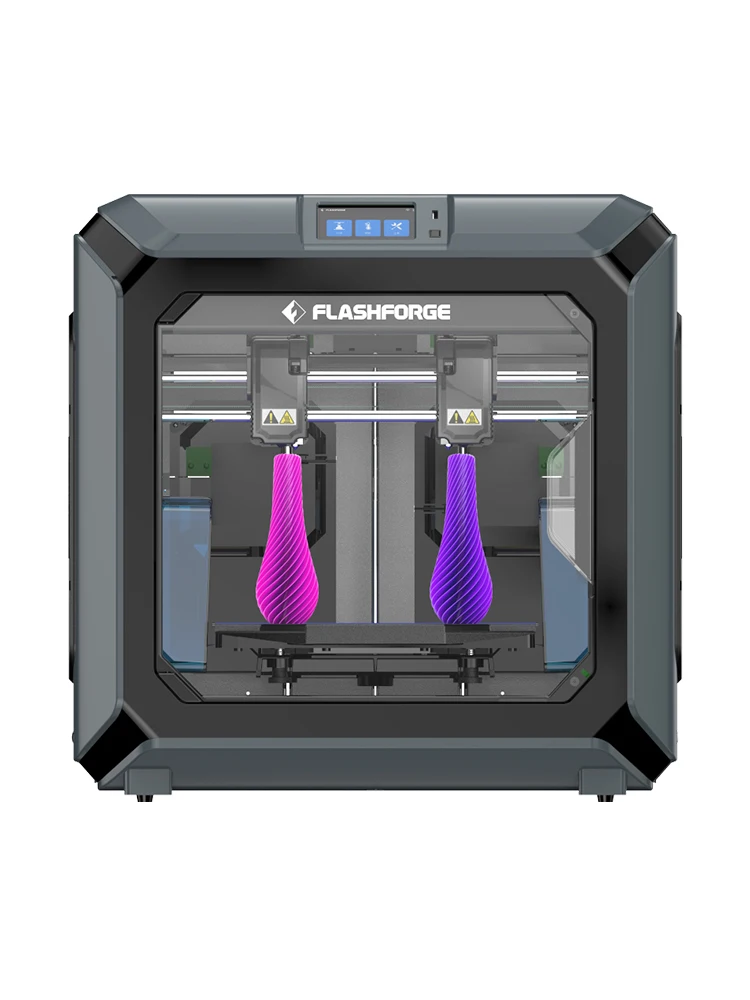 Connected via SD. The layer height is 0.1-0.4 mm.
Connected via SD. The layer height is 0.1-0.4 mm.
Creality CR-10S Pro V2
A 3D printer that delivers high performance and exceptional print stability. Ideal for creating print trusses that produce large runs of the same type of parts. Construction volume - 300x300x400 mm. Print speed - up to 180 mm / sec. (recommended speed is up to 60 mm/s). Layer height - 0.1-0.4 mm. Connection - SD.
Professional 3D printers
Professional-grade printers are designed to produce complex objects using high-temperature engineering plastics and other consumables. Such equipment has a closed chamber to maintain a certain temperature and ensure stable printing.
Best Professional FDM 3D Printers of 2022:
FlashForge Creator Pro 2
Technique with two independent extruders for simultaneous printing of two identical products. The second extruder can be used to create soluble supports for the production of complex models with a quality surface. Construction area - 200x148x150 mm. Layer height - 0.1-0.4 mm, build speed - up to 100 mm/sec. Connection - Usb, SD.
Construction area - 200x148x150 mm. Layer height - 0.1-0.4 mm, build speed - up to 100 mm/sec. Connection - Usb, SD.
Picaso Designer Classic
A printer designed to solve a wide range of tasks. It has built-in profiles for different types of plastic, which makes it easy to start printing. Chamber size - 200x200x210 mm. Work speed - up to 100 cm3 / h, layer thickness - from 0.01 mm. Connection - Usb, Ethernet.
Anycubic 4Max Pro 2.0
Advantages of the model: dual drive extruder for working with soft, flexible plastics, filament end sensor, silent drivers, color display. The device provides the most accurate, stable printing at speeds up to 150 mm/sec. Camera dimensions - 270x210x190 mm. Layer thickness - 0.05-0.3 mm. Types of connection - Usb, SD.
QIDI Tech X-Plus
A printer with a capacious working chamber (270x200x200 mm), one extruder with a heating temperature of up to 300 degrees and a build speed of up to 150 mm/sec.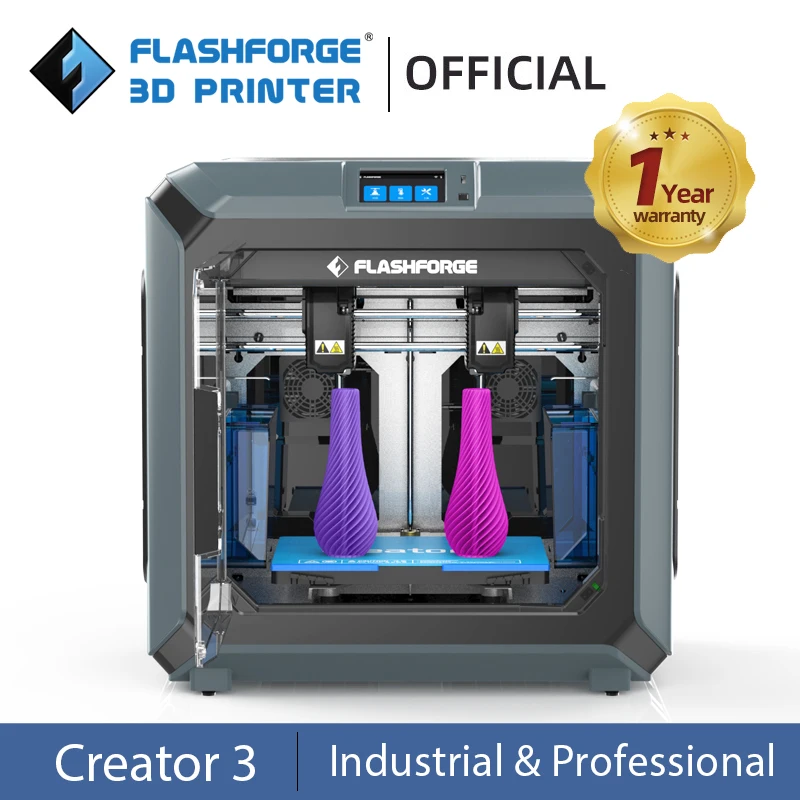 Equipped with a heated platform, connects via Wi-Fi, Usb or LAN, the layer height is 0.05-0.2mm.
Equipped with a heated platform, connects via Wi-Fi, Usb or LAN, the layer height is 0.05-0.2mm.
Professional single extruder 3D printers
Additive equipment of this kind is designed to solve various problems, from relatively simple to complex.
The most popular models of professional FDM/FFF 3D printers with one print head:
Picaso Designer X S2 (Series 2)
The main difference of this modification is the heating of the extruder up to 430 degrees, which allows working with a wide range of plastics, including engineering ones (ABS, PETG, PLA, PEEK, Nylon, Flex, etc.). Dimensions of the working chamber - 201x201x210 mm. Connection - Usb, Ethernet. Speed - up to 150 mm / s. Layer thickness - from 10-250 microns. The printer is equipped with a heated bed.
QIDI X-Max
A 3D printer with a large printable area (300x250x300 mm) and a wide range of useful features. It has a robust design with a strong double Z-rail, a heated platform with a double-sided coating for working with different types of plastic and a 5-inch touch screen. The extruder heats up to 300 degrees. Compatible filaments - PLA, ABS, PETG, PC, Carbon, Nylon, Flex, etc. Connection type - USB storage, LAN, Wi-Fi. Working speed – up to 150 mm/sec. Layer height - 0.05-0.2 mm.
The extruder heats up to 300 degrees. Compatible filaments - PLA, ABS, PETG, PC, Carbon, Nylon, Flex, etc. Connection type - USB storage, LAN, Wi-Fi. Working speed – up to 150 mm/sec. Layer height - 0.05-0.2 mm.
Picaso Designer XL S2
The model is designed for printing with engineering and refractory materials, as the print head heats up to 430 degrees. Robust aluminum body with steel frame guarantees reliability and no vibration during operation. Chamber size - 360x360x610 mm. Speed - up to 130 cm3 / h. Layer thickness - 10-250 microns. Connection type - USB-drive, Ethernet.
TierTime UP300
It is equipped with three separate extruders for working with different materials (low-temperature, high-temperature, standard), as well as various interchangeable platforms (smooth, perforated, glass). Supports print queue for different users. Dimensions of the working area - 205x255x225 mm, layer height - 0.05-0.4 mm. Connection - Usb, LAN, Wi-Fi.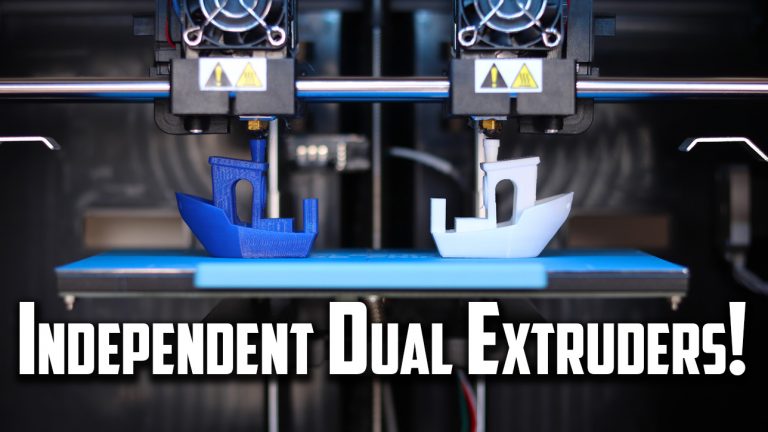
Bizon 3
An updated version of the Bizon 2 model. Layer thickness - 0.02 - 0.65 mm. Print area size: 300x300x400mm. Print speed: up to 160 mm/s. Layer height: from 0.02 to 0.65 mm. Connection type: USB, SD card.
Mid-range large format 3D printers
This category includes models for universities, specialized colleges and offices of medium-sized companies.
The best mid-range large format FDM 3D printers in 2022:
Raise3D Pro3 Plus
Equipment with a transparent body and two extruders equipped with a lifting mechanism, well-thought-out kinematics, interchangeable nozzles of different diameters and a convenient 7-inch color touch screen. Other options: Low Filament Sensor, Print Resume System, RaiseCloud Firmware, Webcam, IdeaMaker Slicer, RaiseCloud Cloud Service. Printed volume: 300x300x605 mm (for one extruder), 255x300x605 mm (for two extruders). Connection - Wi-Fi, Usb, LAN. Speed – up to 150 mm/sec.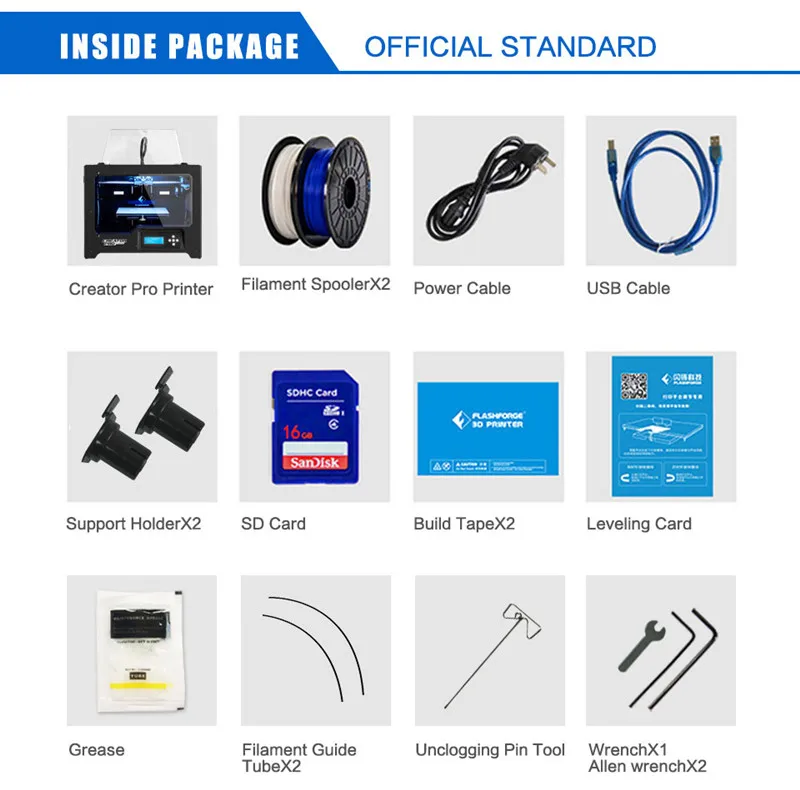 Layer thickness - from 0.01 mm.
Layer thickness - from 0.01 mm.
Flash Forge Creator 4
High-performance, accurate 3D printer with a system of two independent extruders and an advanced thermal management system inside the chamber (to protect against cracking and deformation of engineering plastics). Robust steel body prevents vibration. Print area - 400x350x500 mm. Speed – up to 200 mm/sec. Layer height - from 0.01 mm. Connection - Usb, Wi-Fi, LAN.
Picaso Designer XL Pro S2
Large-format model with a working area of 360x360x610 mm, a heated platform and two extruders with a heating temperature of up to 430 degrees. The device has a simple automatic calibration, a built-in material spool drying mode and a plastic feed control system. Layer thickness - 0.01 mm, speed - up to 130 cm3/h. Connection type - Usb, Ethernet.
CreatBot D600 Pro
The printer with the largest print area is 600x600x600 mm. Equipped with two extruders with heating up to 260 and 420 degrees respectively (for working with standard or engineering plastics). Other features: heated chamber, platform and compartments, speed - up to 120 mm/s, layer thickness - from 0.05 mm. Connection type - Usb.
Other features: heated chamber, platform and compartments, speed - up to 120 mm/s, layer thickness - from 0.05 mm. Connection type - Usb.
Professional Dual Extruder 3D Printers
Professional FDM printers with two extruders are designed to solve the most complex tasks. This technique is equipped with a fully functional slicer and a reliable nozzle lift mechanism or independent extruders.
The most popular professional grade dual extruder 3D printers:
Raise3D Pro2 Plus
The flagship model of the manufacturer, endowed with a full range of useful features. The equipment, enclosed in a transparent case, is connected via Usb, Wi-Fi or LAN and is distinguished by quiet operation. Equipped with an extruder lifting mechanism, a 7-inch color touch screen, a filament end sensor, and a print resume system. Includes RaiseCloud software, webcam, replacement nozzles. Print volume - 305x305x605 mm (for 1 extruder), 280x305x605 mm (for 2 extruders). Speed – up to 150 mm/sec. Layer height - from 0.01 mm. Connection - Usb, Wi-Fi, LAN.
Speed – up to 150 mm/sec. Layer height - from 0.01 mm. Connection - Usb, Wi-Fi, LAN.
Picaso Designer X Pro S2
A compact device with dimensions of the construction area of 201x201x210 mm, providing excellent print quality. It has a high temperature mode with heating up to 430 degrees for printing with complex filaments. Speed - up to 130 cm3 / h, layer thickness - from 0.01 mm. Connection - Usb, Ethernet.
Raise3D E2
High-performance 3D printer with two independent print heads (IDEX system), heated platform and print speed up to 150 mm/sec. A built-in step-by-step video instruction for site calibration is provided. Layer thickness - 0.02-0.25 mm. Connection - Usb port, Wi-Fi, LAN. Print volume - 330x240x240 mm (1 printhead), 295x240x240 mm (2 extruders).
FlashForge Creator 3 Pro
Model with a large chamber (300x250x200 mm), HEPA filter, built-in webcam, color screen and the ability to install hardened nozzles with a material melting point of up to 320 degrees. The heating speed of the working platform is up to 120 degrees in 3 minutes. Print speed - up to 150 mm / sec. Layer thickness - 0.05-0.4 mm. Connection type - Usb, Ethernet, Wi-Fi.
The heating speed of the working platform is up to 120 degrees in 3 minutes. Print speed - up to 150 mm / sec. Layer thickness - 0.05-0.4 mm. Connection type - Usb, Ethernet, Wi-Fi.
CreatBot F430 PEEK
3D printer ideal for PEEK and other filaments. Equipped with a closed chamber with temperature support and two printheads with heating up to 260 and 420 degrees, respectively. Construction area - 400x300x300 mm. Layer height - from 0.02 mm. Speed – up to 180 mm/sec. Connection - Usb.
Ultimaker S5
An easy-to-use device that prints with threads of non-standard diameter - 2.85 mm. The size of the working area is 330x240x300 mm. Layer thickness - from 0.02 mm. Speed - 24 mm3 / sec. Connection type - Usb, Ethernet, Wi-Fi.
Photopolymer desktop 3D printers
Modern models of 3D printing devices using photopolymers are equipped with monochrome displays with a resolution of up to 8K, which provide high speed and quality of building objects of any geometry.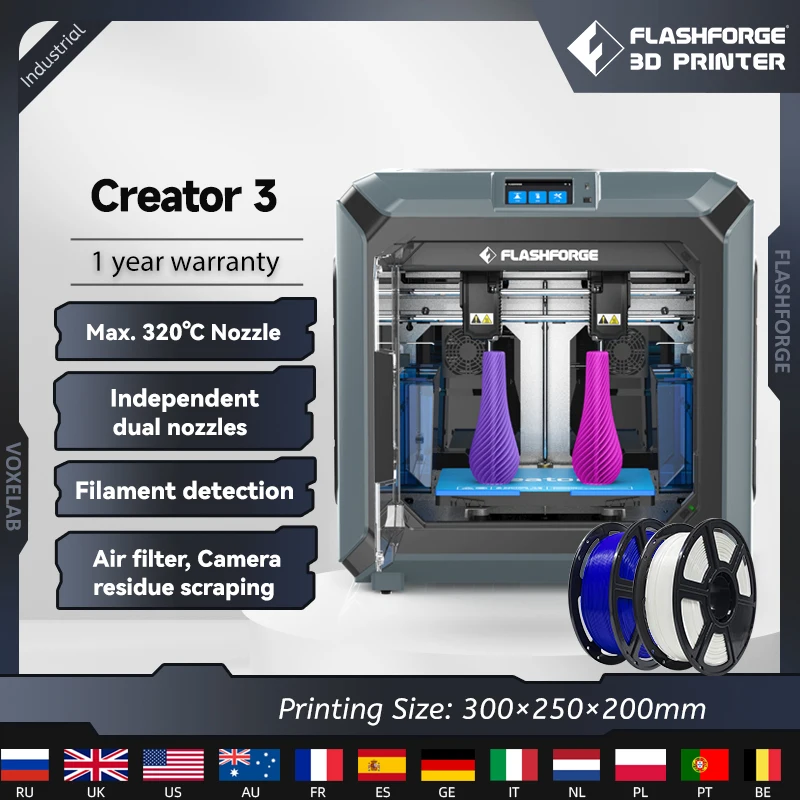
Best photopolymer 3D printers of 2022:
Phrozen Sonic Mini 8K
A compact budget LCD printer with over 2000 hours of uninterrupted operation. Equipped with 8K 7.1” Mono LCD display. Print volume - 165x72x180 mm. Layer height - 0.01-0.3 mm. Resolution along the XY axis - 22 microns.
Phrozen Sonic 4K 2022
Equipment for permanent loads, ideal for dental laboratories and dental clinics. It has a heated chamber 134x75x200 mm with an odor filter and a Mono 4K 6.1” LCD display. Layer thickness - 0.01-0.3 mm.
Formlabs Form 3+
LFS printer with an intuitive interface and many special settings. The light source is a 250 mW laser. The size of the working area is 145x145x185 mm. Layer thickness - 0.025-0.3 mm.
Anycubic Mono X 6K
3D printer with a working chamber 197x122x245 mm and a high-quality Mono 6K 9.25” LCD screen. Layer height - 0.01-0.15 mm.
XYZ Part Pro 150
Equipped with a 5 inch LCD touch screen.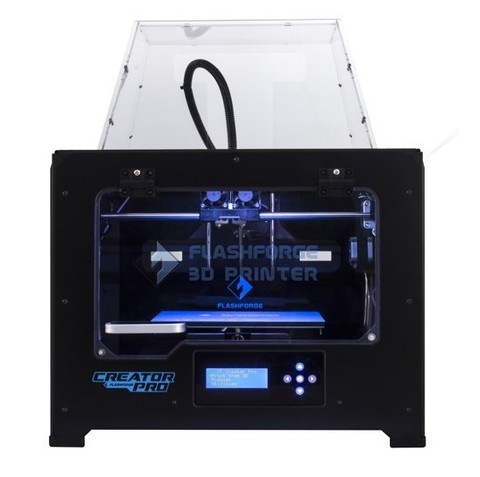 Illumination source: 405 nm UV laser. Print area size: 150x150x200 mm. Layer thickness: 25 to 200 microns (0.025 - 0.2 mm).
Illumination source: 405 nm UV laser. Print area size: 150x150x200 mm. Layer thickness: 25 to 200 microns (0.025 - 0.2 mm).
Best Large Format Desktop Resin 3D Printers
Phrozen Sonic Mega 8K
The best 3D printer in its segment, capable of solving tasks that usually only an entire farm can handle. Suitable for both mass production of small detailed products, and for printing huge objects and dioramas. It is equipped with a 15-inch Mono 8K LCD display and has a working area of 330x185x400 mm. Resolution - less than 50 microns, layer height - 0.01-0.3 mm.
Formlabs Form 3L
LFS-technique with a construction area of 335x200x300 mm, creating high-precision details using a 2x250 mW laser with a spot diameter of 85 microns. It is possible to install two cartridges at the same time for uninterrupted printing of large models. Layer thickness - from 0.025 mm.
Totals
All 3D printers reviewed have been rigorously tested in practice and tested by experienced engineers. Each of them has its own advantages and disadvantages, therefore, when choosing a model, it is necessary to focus, first of all, on the expected result, equipment functionality and budget.
Each of them has its own advantages and disadvantages, therefore, when choosing a model, it is necessary to focus, first of all, on the expected result, equipment functionality and budget.
If you find it difficult to make a choice, please contact 3DTool. Our experts will help you choose the right 3D equipment and consumables for you.
Techno Print 3D Company
This is our first review of the most popular and inexpensive 3D printers for 2020. The list will include the best-selling devices in two price ranges (up to 30 tr and up to 60 tr). Printers working with both plastic filament (FDM) and photopolymers (LCD/DLP) will be presented. This list will always be up to date, as it is periodically updated and supplemented. Read more→
The Chinese company Dazz3D announces the launch of the project on KickStarter and accepts pre-orders for Dazz3D Basic and Dazz3D Pro 3D printers. These revolutionary new devices are aimed at both the professional and amateur markets.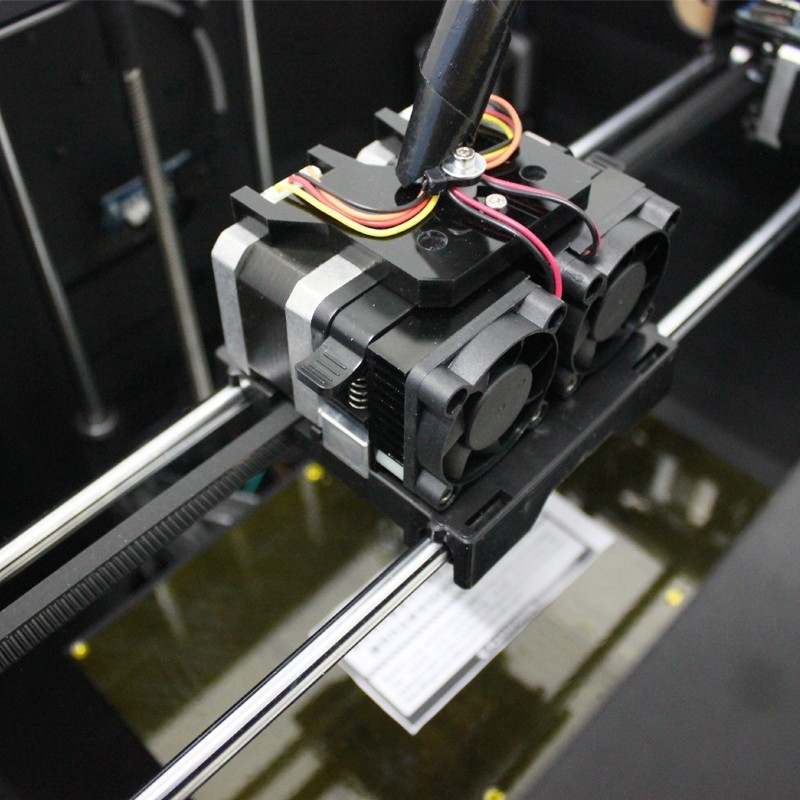 Read more→
Read more→
We all know that precise calibration of the 3D printer desktop is the foundation and the key to successful printing on any FDM printer. In this article we will talk about the main and most popular ways to level the "bed". So, as mentioned above, 3D printing without desktop calibration is impossible. We face this process Read more→
It's hard to go through a day today without hearing about 3D printing technology, which is bursting into our lives at an incredible speed. More and more people around the world are becoming addicted to 3D printing technology as it becomes more accessible and cheaper every day. Now almost anyone can afford to buy a 3D printer, and with the help of Read more→
The FormLabs Form 2 and Ultimaker 3 are perhaps the most popular 3D printers today, capable of high quality printing with incredible surface detail. Moreover, these two devices use completely different technologies, and therefore, there are a lot of differences between them.